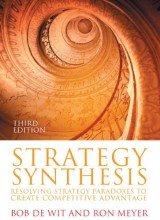Principles of Scenario Planning - Strategising--> strategy as a loop, it is never finished - Business Idea
14 important questions on Principles of Scenario Planning - Strategising--> strategy as a loop, it is never finished - Business Idea
What do we understand under business idea?
The organisations mental model of the forces behind its current and future business success.
What is entrepreneurial success?
Entrepreneurial success is a result from a combination of:
- Discovering a new way of creating value for customers
- Bringing together a combination of competencies, which creates this value.
- Creating uniqueness in this formula in order to appropriate part of the value created.
What is the Devil's advocate question about?
What is unique about this particular formula, and why are others unable to emulate it?
- Higher grades + faster learning
- Never study anything twice
- 100% sure, 100% understanding
Which two distinctive competencies categorie do we have?
- Uncodified institutional knowledge
- in networked people
- in embedded processes
- Sunk Costs/Irreversible investments
- investments in reputation
- in legal protection
- in specialised assets
Where can we find uncodified institutional knowledge in an organisation?
- In networked people
-Institutional R&D capability
- Company know-how
- Functional knowledge pools
- Knowledge of customer value systems
- Shared assumptions and values.
- In embedded processes
- leadership style and commitment
- access to consumers
- access to distribution channels
- institutional relationships with government
- internal communication, systems/culture
- staff identification with the firm, staff commitment
Where can we find irreversible investments?
- Investments in reputation
- Brand
- Dominant size and presence
- Installed base
- Finincial clout
- In legal protection (patents)
- concession agreements
- patents
- ownership of prime sites
- In specialized assets
- Investments in dominant size, market share and image.
- Sunk investment in sites, exploration, experimentation, specialized equipment etc.
- Investments in economies of scale, e.g. in distribution (e.g. low stock levels, low unit overheads)
- First mover investments in production capacity.
When is the Business Idea at its strongest? Give an example.
The Business Idea is at its strongest, if the underlying distinctive competencies reinforce eachother.
For example the Business Formula of IKEA. Each and every distinctive competence reinforeces eachother.
What are the 3 characteristics of a feedback loop?
- Reinforcement can spiral in two opposite directions.
- Near the switching point, only a small push is needed to flip from growth to decline.
- Also, as time passes, the feedback loop also slowly moves from positive to negative.
Which two questions should we take in account due to windtunneling?
Questions about value creation and organizational development.
What question comes along with value creation?
Will the customer value system overlap sufficiently with the competence system envisaged to create significant new and surplus value?
What question comes along with organizational development?
Will the organization be able to appropriate enough of the surplus for its own development?
What are the answers if we are sufficient prepared for the future?
If yes: can we expand our portfolio (enter new markets, start new joint ventures)?
If no: what do we have to learn to be better prepared?
What is the difference between the vision of the future and the strategic vision?
Vision of the future: the scenarios
Strategic vision: the future Business Idea.
How can we move the Business Idea forward?
1. By entrepreneurial invention.
2. By building on the existing distinctive competencies.
The question on the page originate from the summary of the following study material:
- A unique study and practice tool
- Never study anything twice again
- Get the grades you hope for
- 100% sure, 100% understanding






























